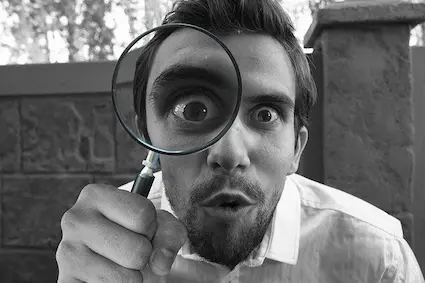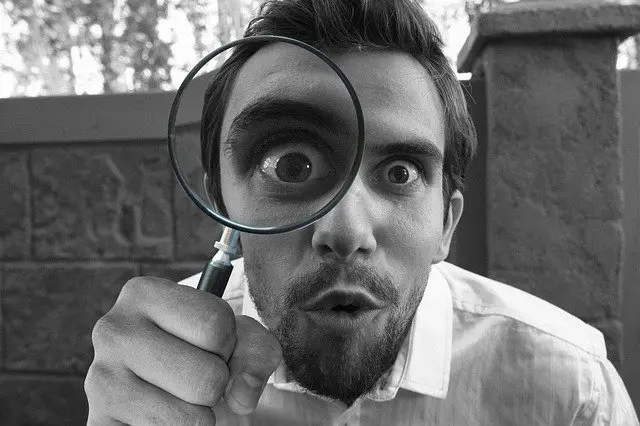Absorb Knowledge and Stay Current
Modern technology has made it easier than ever to learn about coins and stay informed on current events related to the hobby. Become an insatiable absorbent sponge and soak up the flow of knowledge available to you…
- Subscribe to Coin Periodicals
- Free Newsletters
- Auction Catalogs
- Numismatic Associations
- Assemble a Numismatic Library (print or virtual)
- Newman Numismatic Portal
- Counterfeits and Forgeries
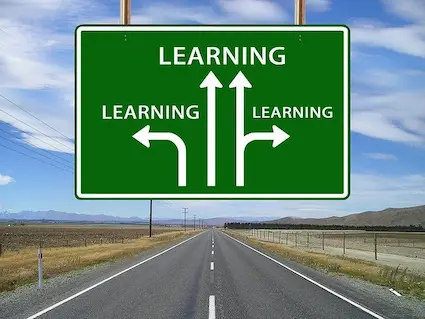
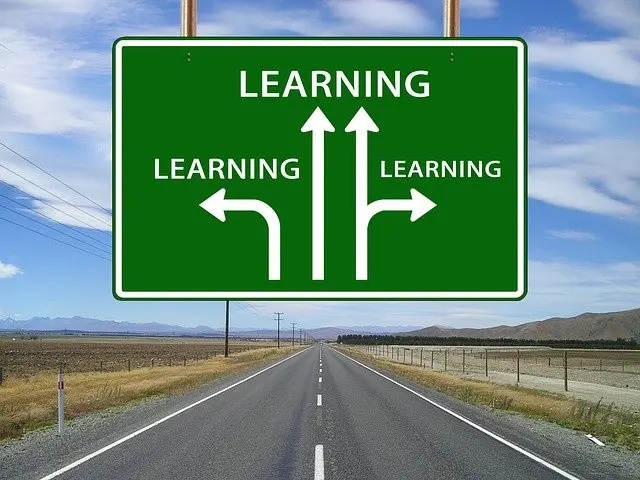
Subscribe to Coin Periodicals
Subscribe to at least one of the hobby’s periodical publications. When getting started in coin collecting, this is one of the first turnstiles through which you should pass to get off the sidelines and into the game.
You’ll stay updated on the latest hobby news and consume a range of thought and opinions. Coin World and Numismatic News are two of the leading weekly publications.
The annual subscription fees are quite modest, and even less if you opt for digital delivery only. Past issues are archived and searchable, so right off the bat you have an immense digital library at your fingertips.
Free Newsletters
Yes, you can actually get something for nothing! There are worthwhile newsletters that summarize headlines in the world of coin collecting, and they don’t charge a cent. You do not have to become a paid member to receive any of these newsletters. Here are the ones I’m signed up for:
- NGC Weekly Market Report: Contains keen insight from coin professionals on the frontlines of the industry.
- NGC eNewsletter: Monthly publication highlighted by engaging commentary and educational material.
- PCGS Newsletter: This newsletter keeps you updated on current events in the coin business. In addition, you’ll be treated to an interesting array of lessons intended to buttress your numismatic IQ.
- Greysheet Weekly News Headlines: The biggest stories of the week in the world of numismatics. All the headlines are in a concise format, with links to full length reports.
There are more freebies than just these, but this is a very good start.
Like most busy people, you may not have time to thoroughly digest every article in these newsletters, but just skimming through the headlines is a meaningful exercise. Of course, if there is a story in particular that piques your interest, by all means click the link to get the full scoop.
Naturally, you have to surrender your email to get on their distribution lists. In my experience, this has not created a flood of spam in my Inbox, so there’s really no downside in taking advantage of these free resources.

Auction Catalogs
One of the most overlooked educational opportunities is the catalogs produced by premier numismatic auction houses. Take advantage of them. Here again, it won’t cost you a cent.
You’ll discover a wealth of information and gasp at the stunning photography. The extraordinary work of the catalog researchers will boost your numismatic skill level to new altitudes, as you learn why certain coins garner incredible respect (and $$$ value) from collectors. Your grading skills will rise a notch or two as well.
Auction catalogs are typically archived online and go back to the 1990s, along with Prices Realized data, making it possible to DIY value trend research.
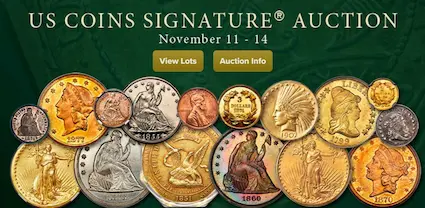
One of the most overlooked educational opportunities is the catalogs produced by premier numismatic auction houses. Take advantage of them. Here again, it won’t cost you a cent.
You’ll discover a wealth of information and gasp at the stunning photography. The extraordinary work of the catalog researchers will boost your numismatic skill level to new altitudes, as you learn why certain coins garner incredible respect (and $$$ value) from collectors. Your grading skills will rise a notch or two as well.
Auction catalogs are typically archived online and go back to the 1990s, along with Prices Realized data, making it possible to DIY value trend research.

Some of the superlative coin auction catalogs are produced by Goldberg Coins, Stack’s Bowers Galleries, and Heritage Auctions.
Request to be added to their email distribution lists. That way, you won’t miss out on any upcoming auctions. On top of that, you’ll receive follow-up emails with auction results and other supporting details.
Moreover, these auction houses are some of the best places to find coins for the discerning collector, so getting familiar with the faces in these companies and how they operate will benefit you when the time is right to purchase some classic United States rare coins.
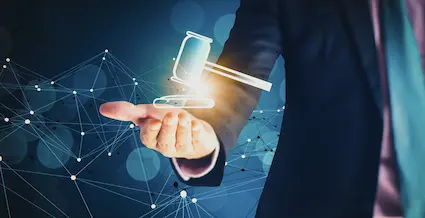
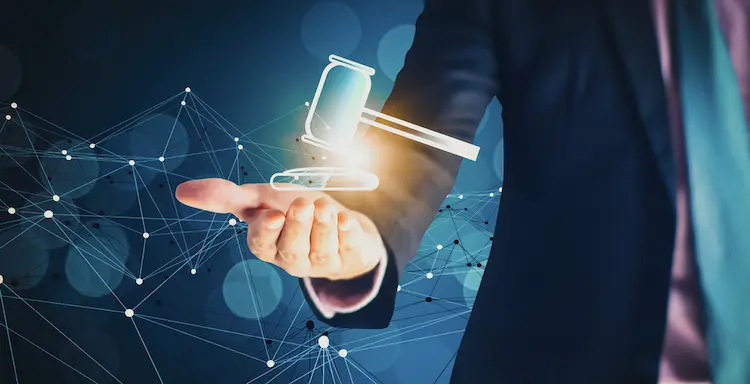
Numismatic Associations
An organization you shouldn’t overlook is the American Numismatic Association. The ANA was founded in 1891 and today has about 25,000 members. Their home base is in Colorado Springs, CO.
The list of ANA membership benefits reads like a dream-come-true for numismatists thirsting to learn more. Their webinars, in-person seminars, correspondence courses, and teaching videos are top-of-the-line instructional opportunities.
Hundreds of ANA educational videos are archived on YouTube for easy retrieval.
For researchers, one of the most important privileges of an ANA membership is access to the world’s largest numismatic library (that’s how I was able to reconstruct coin value trends dating back to 1950).
Another benefit is the monthly edition of The Numismatist, the official publication of the ANA, containing information of interest to coin collectors of all sorts. Their articles are quite scholarly and in-depth. Volumes of The Numismatist have been digitally archived from the 19th century to the present and are searchable.

An organization you shouldn’t overlook is the American Numismatic Association. The ANA was founded in 1891 and today has about 25,000 members. Their home base is in Colorado Springs, CO.
The list of ANA membership benefits reads like a dream-come-true for numismatists thirsting to learn more. Their webinars, in-person seminars, correspondence courses, and teaching videos are top-of-the-line instructional opportunities.
Hundreds of ANA educational videos are archived on YouTube for easy retrieval.
For researchers, one of the most important privileges of an ANA membership is access to the world’s largest numismatic library (that’s how I was able to reconstruct coin value trends dating back to 1950).
Another benefit is the monthly edition of The Numismatist, the official publication of the ANA, containing information of interest to coin collectors of all sorts. Their articles are quite scholarly and in-depth. Volumes of The Numismatist have been digitally archived from the 19th century to the present and are searchable.

Annual ANA dues for an adult Gold membership costs $35/year. Youth membership is even less. You’ll never find a better bargain.
I’ve been an ANA member since circa 1984, although I must confess my membership lapsed for a few years when I was preoccupied with career, changing diapers, little league games… that kind of stuff. Looking back, I realize it would have been better had I scraped together the cash early on to buy a lifetime ANA membership – good advice to those of you who may just be starting out.
The American Numismatic Society, founded in 1858, also provides outstanding benefits and reference material and is headquartered in New York City. (Sorry, ANS for shortchanging you here – I just don’t have any first-hand experience with your organization -- but anyone around for as long as you have been must be doing something right).
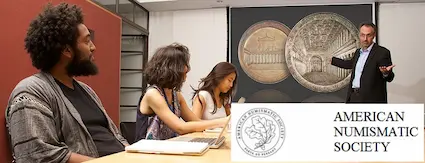
As coin collectors, it’s really important to support these associations, whether we chose to avail ourselves to their educational resources or not. They do a lot to nurture and grow our hobby, but need paid memberships to continue their excellent work. It’s a mutually symbiotic relationship – we help them to help us and vice versa.
Consider the relationship between flowers and bees. As the bee gathers nectar for nutrition, pollen clings to their body parts and is transported to other flowers to promote flower pollination. This mutualistic rapport propagates the flower species while feeding the bees.
Which do you want to be? The flower or the bee? Doesn’t matter, just pick one and join today!
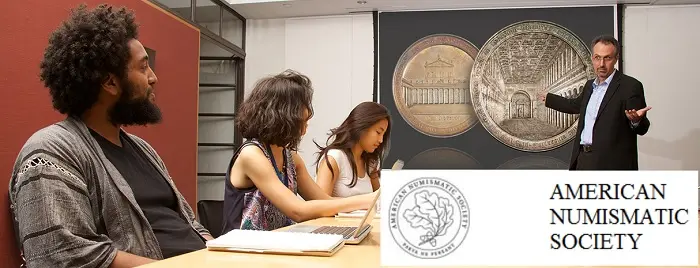
As coin collectors, it’s really important to support these associations, whether we chose to avail ourselves to their educational resources or not. They do a lot to nurture and grow our hobby, but need paid memberships to continue their excellent work. It’s a mutually symbiotic relationship – we help them to help us and vice versa.
Consider the relationship between flowers and bees. As the bee gathers nectar for nutrition, pollen clings to their body parts and is transported to other flowers to promote flower pollination. This mutualistic rapport propagates the flower species while feeding the bees.
Which do you want to be? The flower or the bee? Doesn’t matter, just pick one and join today!
Assemble a Numismatic Library (print or virtual)
Start up a personal numismatic library, purchasing books to educate yourself about the workings of the hobby and particular coins that you are fervently drawn to.
If someone did a scientific study on collectors who have sold their coins for a huge amount above what they paid for them, there would likely be a distinct correlation uncovered: Those collectors who were rewarded with the highest percent returns also owned the largest personal numismatic libraries.
Some collectors are okay with digital downloads. Personally, I prefer printed books I can lay my hands onto. A good way to save money is order used books at a fraction of their new price.
Here are couple of *MUST HAVE* recommendations to start your library:
As an Amazon Affiliate I earn from qualifying purchases, at no added cost to you. Thank you!
A Guide Book of United States Coins, by Jeff Garrett, et.al.
Also known as “The Redbook”, this handy reference has been published annually since 1946. The Redbook was the first addition to my personal library, obtaining a copy at age 10 in 1969. I used it so much the pages started falling out of the book. Collectors at all levels value the Redbook for its information on mintages, coin variety descriptions, photos, and plenty more. This is “gold standard” reference for collectors at all levels (but it’s not necessary to buy a new release copy every year).
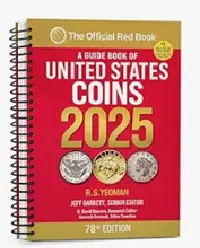
American Numismatic Association Grading Standards for United States Coins, 7th edition, by Kenneth Bressett
Virtually all coin grading for the last several decades is [supposedly] based on the standards established by the ANA. This is their official grading publication. What more is there to say?
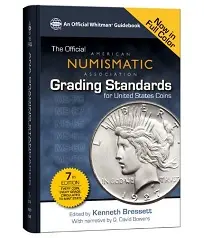
The following books deal with coin collecting in general, but provide practical advice to help newbies merge into the mainstream of the hobby accident-free. Grizzled veterans will view these as entertaining refresher materials as well.
There are many books on getting started in coin collecting, but I’ve isolated a few of the finest, all written by accomplished numismatic experts, whose work I have consumed with enjoyment and awe throughout much of my lengthy collecting career.
Coin Collecting for Beginners 2025 by Spencer Reed
This is a comprehensive guide detailing things a new collector needs to know to become successful. Many topics covered, including coin grading, valuation, protecting your collection. Lots of tips on setting goals and collecting strategy, all explained in a friendly writing style by a dedicated numismatist.
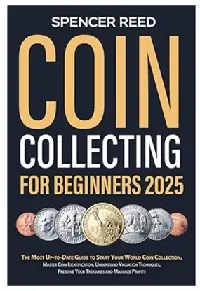
Whitman Guide to Coin Collecting: An Introduction to the World of Coins, by Kenneth E. Bressett
Longtime numismatic sensation Ken Bressett has written one of the finest references ever for newcomers to the hobby. He explains the basics from A to Z in a fun and easy to understand approach. After reading this one, you’ll be filled with confidence and pleased with your decision to get involved with coin collecting.
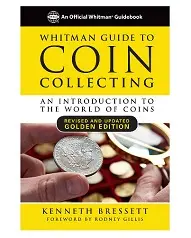
Coin Collecting for Dummies (3rd edition), by Neil S. Berman
Just like all the other books in the “Dummies” franchise, humor plays a role in relaxed learning. Not sure what steps to take first in getting started in coin collecting? This book shows you how to get your feet wet right off the bat. It will help you figure out where your collecting passions truly lie. It describes organizational and analytical skillsets while explaining techniques to assess coin value. It teaches where, when, how, and why to buy specific coins you will be proud to own or pass on to your heirs.
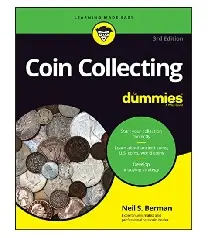
100 Greatest U.S. Coins, 6th Edition, by Jeff Garrett and Mark Salzberg
As the title suggests, this beautiful book explores 100 of the greatest U.S. coins. These are the coins collectors fight for with bare knuckles, metaphorically speaking. Not coincidentally, most of them are solid bets to climb sharply in value, just as they have demonstrated for many decades. Many of these coins are recommended in the Key Date Coin List, but with this book, you’ll get a deeper understanding of their historic legacies and continued popularity and demand.
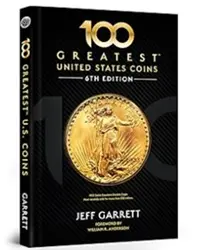
Coin Collecting for Beginners 2025 by Lincoln Ford
Here's another book aimed at newbies to the coin collecting hobby. There are lots of new books for beginners on Amazon, yet another indicator how coin collecting is thriving today. This comprehensive guide is heavily illustrated and well-written.
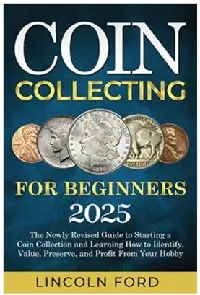
Eventually, most new collectors who stick with the hobby will develop a desire to learn more about a specific area of coin collecting. Perhaps it is Morgan dollars from the Carson City Mint or Indian Head cents that warm your heart.
Amazon got started back in the 1990s selling books. Now they sell everything under the sun, but remain a leader in book retailing. One of the best things about Amazon is that you can save a lot of money buying slightly used books.
Whatever your interest might be might be, chances are good someone has already published a definitive work on the subject that will become the most summoned reference in your library. Never let your pursuit for knowledge to be extinguished and someday YOU may be writing the next great definitive work.
Eventually, most new collectors who stick with the hobby will develop a desire to learn more about a specific area of coin collecting. Perhaps it is Morgan dollars from the Carson City Mint or Indian Head cents that warm your heart.
Amazon got started back in the 1990s selling books. Now they sell everything under the sun, but remain a leader in book retailing. One of the best things about Amazon is that you can save a lot of money buying slightly used books.
Whatever your interest might be might be, chances are good someone has already published a definitive work on the subject that will become the most summoned reference in your library. Never let your pursuit for knowledge to be extinguished and someday YOU may be writing the next great definitive work.
Newman Numismatic Portal
A new numismatic resource has burst onto the scene in recent years. The Newman Numismatic Portal endeavors to become the heavyweight champion of online numismatic libraries. It already offers an extensive range of reference materials, but much more is promised.
There is no charge to tap into this vast resource.
Funded by the Eric P. Newman Numismatic Education Society, this invaluable research site has risen rapidly in search engine results for coin collecting researchers.
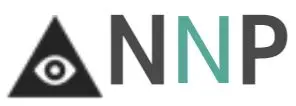
Counterfeits and Forgeries
Coin counterfeits and forgeries have been around since shortly after the Ancients invented coins thousands of years ago.
Along with disingenuous grading, coin fakery occupies the dark underbelly of our hobby. It may occur in many forms of coin copying, altering, or “doctoring”. The one thing they all have in common is they are intended to deceive buyers.
Believe it or not, it is not unusual to find counterfeit grading service holders affixed with fake grading labels for sale on the open coin market. It really can get that bad.
It's unfortunate this topic has to be introduced in a "Getting Started in Coin Collecting" primer, but, as they say, "it is what it is."
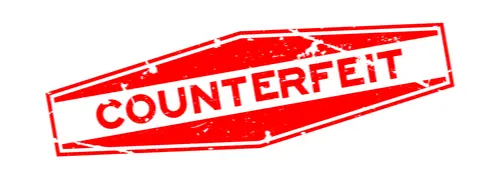
The good news is that if you buy certified coins from a highly reputable dealer, chances are remote you’ll become a victim. Professional coin graders and good dealers are already experts at intercepting counterfeits and forgeries before they reach you. (Opposite of that, a dealer with little skill at detecting fakes may not pass the “survival of the fittest” test and be forced into extinction).
All the same, every serious collector should become at least somewhat educated in the “trade” of counterfeits and forgeries. Being able to detect a counterfeit when you see one may prevent you someday from making a costly mistake.
Thankfully, there are numerous tools to help the collector become more adept at spotting fakes. Here are a couple of richly illustrated books exposing the tactics historically employed by this brand of white-collar criminals:
Numismatic Forgery, by Charles M. Larson
Author Charles Larson interviewed one of the most notorious numismatic fakesters of all time as he sat in his prison cell. Methods and techniques of the criminal mind revealed.
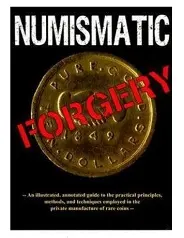
United States Gold Counterfeit Detection Guide, by Bill Fivaz
Although this book covers gold coins only, it illustrates diagnostics of detecting the most frequently encountered counterfeits in today’s marketplace, supported by experienced graders, authenticators and coin dealers. Covers the basics and beyond.
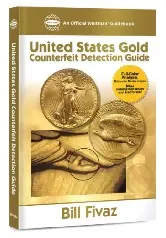
The American Numismatic Association is acutely aware of the dangers posed by fake coins, and offers courses and instructor-led training for collectors wanting to get better at identifying fakes. There is usually something on the docket coming up soon. Highly recommended.
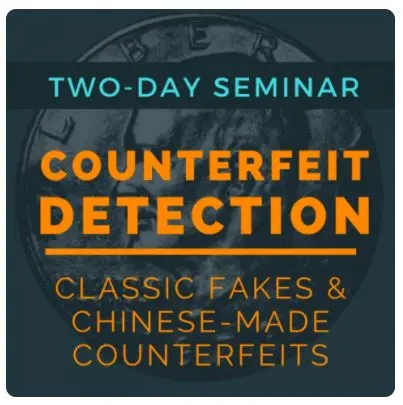
Some fakes are extremely well done and require significant expertise to detect. Many others are the buffoonish work of amateurs.
Let’s take a time out and look at a few humorous counterfeits…
Back in 2012, I was advised by “experts” that if I wanted to build a traffic base for my coin information website, it was imperative to establish a presence on social media.
In the years that followed, social media did not help grow my business one iota. What it did accomplish, however, was to flood my Inbox from all around, mostly from people wanting help appraising or selling their coins.
The social media milieu is a natural attractant for fakery of all kinds, including coins. For example, I have been pitched more 1804 Draped Bust U.S. silver dollars than are known to exist. Let me share a few of those, along with a few other goofy counterfeits.
As you are about to witness, some of these photos and conversations are rather amusing. Be sure to catch the dialogue in the caption boxes below the images...
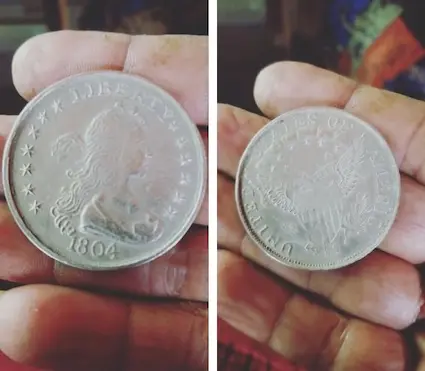
Dan: It is a fake. A real 1804 US silver dollar is worth $1 million or more.
Poster: How did u know please 😊
Dan: Check out this real 1804 dollar. You will see it is made of silver and has different features than your coin.
Poster: lier
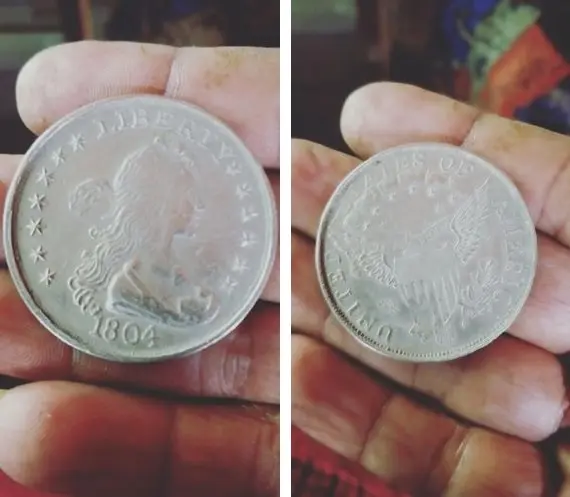
Dan: It is a fake. A real 1804 US silver dollar is worth $1 million or more.
Poster: How did u know please 😊
Dan: Check out this real 1804 dollar. You will see it is made of silver and has different features than your coin.
Poster: lier
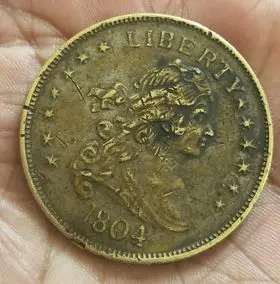
Dan: Fake. Worth $0. Sorry.
Poster: Is this fake?
Dan: Yes. Sorry, it has 0 value.
Poster: How I know you tell truth?
Dan: Is your coin made of silver? Obviously not.

Dan: In my opinion, they are all fake. Wish I had better news for you.
Poster: Thanks Dan. Pls help identify the fake and genuine coins and also let me know how much you buy genuine coins please. Need you help and Support Dan.
(one month later)
Poster: Hello Dan, how are you ? Sharing coins which I referred earlier. Pls assist with your knowledge and experience.
Dan: All the coins look fake to me. For example, you have an “1865 dollar” that somewhat resembles a modern-day Washington quarter. No such coin was ever made. Same can be said for 1851 “Indian Head dollar”. These are counterfeits and have no value. You should stop trying to peddle them.

Dan: In my opinion, they are all fake. Wish I had better news for you.
Poster: Thanks Dan. Pls help identify the fake and genuine coins and also let me know how much you buy genuine coins please. Need you help and Support Dan.
(one month later)
Poster: Hello Dan, how are you ? Sharing coins which I referred earlier. Pls assist with your knowledge and experience.
Dan: All the coins look fake to me. For example, you have an “1865 dollar” that somewhat resembles a modern-day Washington quarter. No such coin was ever made. Same can be said for 1851 “Indian Head dollar”. These are counterfeits and have no value. You should stop trying to peddle them.
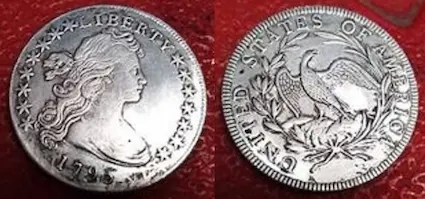
Dan: The 1795 coin is fake and has 0 value. The lettering isn’t right and coin doesn’t look silver.
Poster: I dont think its fake. Because my father in law got it from the ground. It was under the ground for a very long time already.
Dan: I've been collecting U.S. coins for 54 years. I guess I don't know anything, do I? Best wishes for you...
Poster: Maybe it is more than 54 years in the ground. Thanks for your help anyway.
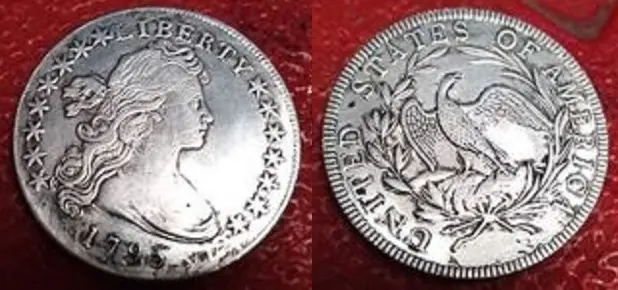
Dan: The 1795 coin is fake and has 0 value. The lettering isn’t right and coin doesn’t look silver.
Poster: I dont think its fake. Because my father in law got it from the ground. It was under the ground for a very long time already.
Dan: I've been collecting U.S. coins for 54 years. I guess I don't know anything, do I? Best wishes for you...
Poster: Maybe it is more than 54 years in the ground. Thanks for your help anyway.
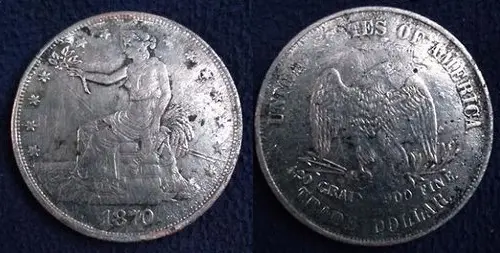
Dan: I can tell you this coin is a fake. Not real. Worth $0. The easiest way to know this is this coin type was minted only from 1873-1885. None were made in 1870. Sorry to be the one to tell you this.
Poster: The coin was from a fire house
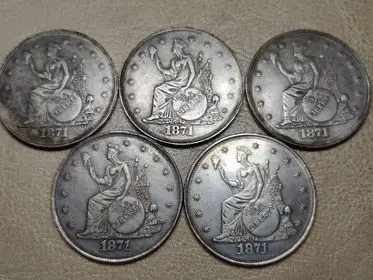
Dan: These are fake. Not interested.
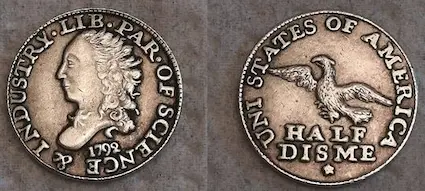
Dan: What you have resembles a 1792 half disme. This was the first coin struck by the U.S. government. A genuine specimen is worth many thousands of dollars. Unfortunately, your coin is fake because the features do not match those of a genuine specimen. Here is a link to a real one for comparison.
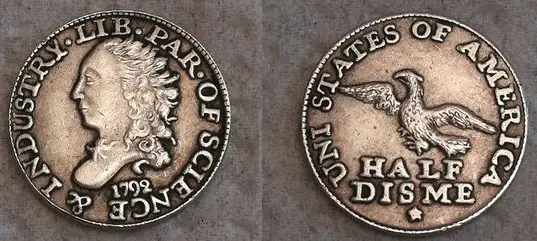
Dan: What you have resembles a 1792 half disme. This was the first coin struck by the U.S. government. A genuine specimen is worth many thousands of dollars. Unfortunately, your coin is fake because the features do not match those of a genuine specimen. Here is a link to a real one for comparison.

Dan: Sorry, its fake and has zero value as a collectible coin.
Poster: Are u sure it's fake
Dan: Yes, its fake. Have you ever seen a penny that big?
Poster: Oh common this antique from my great grandfather

Dan: Sorry, its fake and has zero value as a collectible coin.
Poster: Are u sure it's fake
Dan: Yes, its fake. Have you ever seen a penny that big?
Poster: Oh common this antique from my great grandfather
Amateur hour has now concluded.
As you can see from the examples above, some counterfeits are easily spotted with rudimentary collector knowledge. In their quest to steal a fast buck, many fraudsters don’t pay enough attention to detail. They often get dates, mint marks, and design features pitifully wrong.
After you’ve looked at enough genuine coins, your intuition will quickly steer you to safety if presented with a lower-level fake.
Sadly, there are real experts in the counterfeit business too, and they tend to focus on expensive coins. Even if you become moderately good at identifying counterfeits and forgeries, their work is so sophisticated that it takes a professional who handles coins daily to catch their deception.
To be a well-rounded collector, learn as much as you can about fakes. No matter how good you get at detecting fakes, never purchase an expensive coin from a potentially shady character. The abundance of fakes is yet another indication why you should never buy a high-end coin from anyone other than a reputable seller.
Quick Links to Other "Getting Started in Coin Collecting" Chapters...
The next chapter in this section is What to Collect?
Use the links directly below to navigate the "Getting Started in Coin Collecting" section.
- Coin Grading Basics
- Absorb Knowledge and Stay Current (the current chapter)
- What to Collect?
- Understanding Quality
- Develop a Passion for Coins
- Get to Know People
- Handling & Storing Numismatic Treasures
- Coin Lingo
- Best Places to Buy Coins
All the chapters referenced above are accessible from any other chapter in this section. Thus, no need to return to the Getting Started in Coin Collecting Introductory page to link to other chapters.


